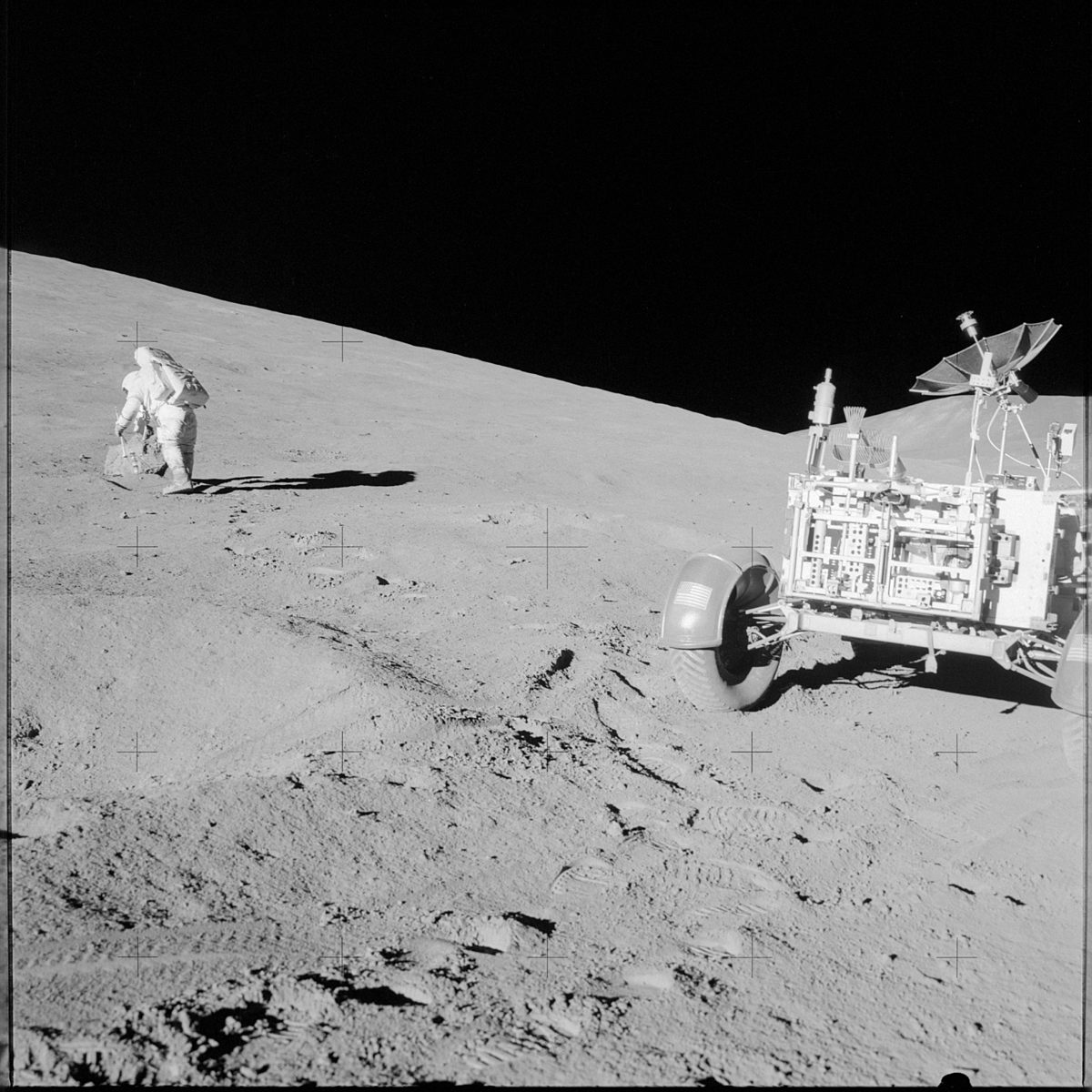Apollo 11 was the first mission to land humans on the Moon. It fulfilled a 1961 goal set by President John F. Kennedy to send American astronauts to the surface and return them safely to Earth before the end of the decade. On 21 July 1969 at 02:56:15 UTC, Neil Armstrong pressed his left foot onto the Moon and said, "That's one small step for [a] man, one giant leap for mankind," as 530 million people watched live on television.
The mission returned 20 kilograms of rock and soil to Earth, and paved the way for 5 additional Moon landings that greatly advanced the field of lunar science.

Neil Armstrong, Buzz Aldrin, and Michael Collins began their journey with a launch aboard a Saturn V rocket on the morning of 16 July 1969. Three hours later, their rocket's upper stage blasted them out of Earth orbit towards the Moon. They arrived 3 days later on 19 July and entered an initial lunar orbit of 111 by 306 kilometers. A second engine burn lowered their orbit to 100 by 113 kilometers.
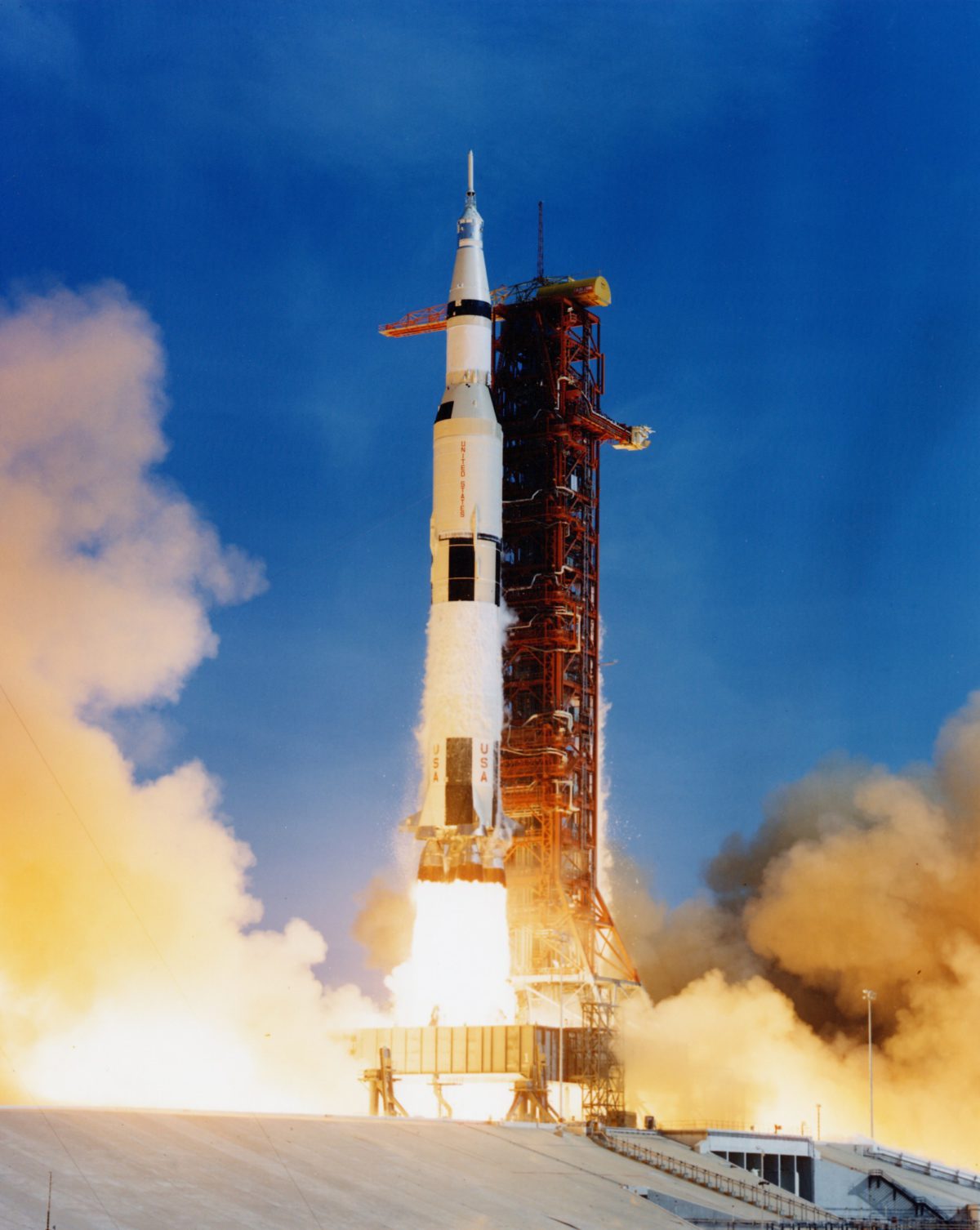
On 20 July, Armstrong and Aldrin boarded their lunar module, nicknamed Eagle, and undocked it from the command module, where Collins remained. Almost the same as in the Apollo 10 rehearsal 2 months earlier, the astronauts fired Eagle’s descent engine, dropping to an orbit with a low point of 14.5 kilometers. Roughly an hour later, as the duo approached the Sea of Tranquility, they began a final powered descent to the surface.
Armstrong and Aldrin had to overcome several last-minute challenges during the landing sequence. A series of computer alarms that the crew had not seen in simulations prompted a call to Mission Control for guidance, and flight controllers advised the crew they could safely proceed. Then, Armstrong saw that the lunar module computer was guiding them toward a boulder field that was later determined to be ejecta from West Crater. Armstrong took semi-manual control of the lunar module to avoid the boulders, and then a smaller crater later named Little West, before finally landing with just 25 seconds' worth of fuel remaining.
"Houston, Tranquility Base here. The Eagle has landed," Armstrong famously reported after landing. The official touchdown time was 20:17:39 UTC on 20 July 1969.

Safely on the surface, Armstrong and Aldrin worked through a long checklist to ensure their spacecraft was healthy and that they would be able to lift off for the return home. The flight plan called for an optional 4-hour rest period to begin 2 hours after landing, which Armstrong and Aldrin opted to skip. It is often reported that the astronauts were too excited to rest; in reality, the rest period was an optional buffer in case Armstrong and Aldrin needed time to adapt to lunar gravity or had technical problems to work through.
EVA preparations officially began three and a half hours after landing. The lunar module hatch opened at 02:39:35 UTC on 21 July 1969, and 17 minutes later, at 02:56:15 UTC (22:56:15 EDT on 20 July 1969), Armstrong stepped off the lunar module's ladder and onto the surface.
Armstrong and Aldrin's single moonwalk lasted two and a half hours. During that time, they deployed science and engineering experiments, photographed their surroundings, displayed an American flag, read an inscription plaque, collected rock and soil samples for return to Earth, and spoke with President Richard Nixon. The astronauts verbally described their surroundings and progress for geologists, while cameras mounted inside and outside the lunar module documented some of their activities.
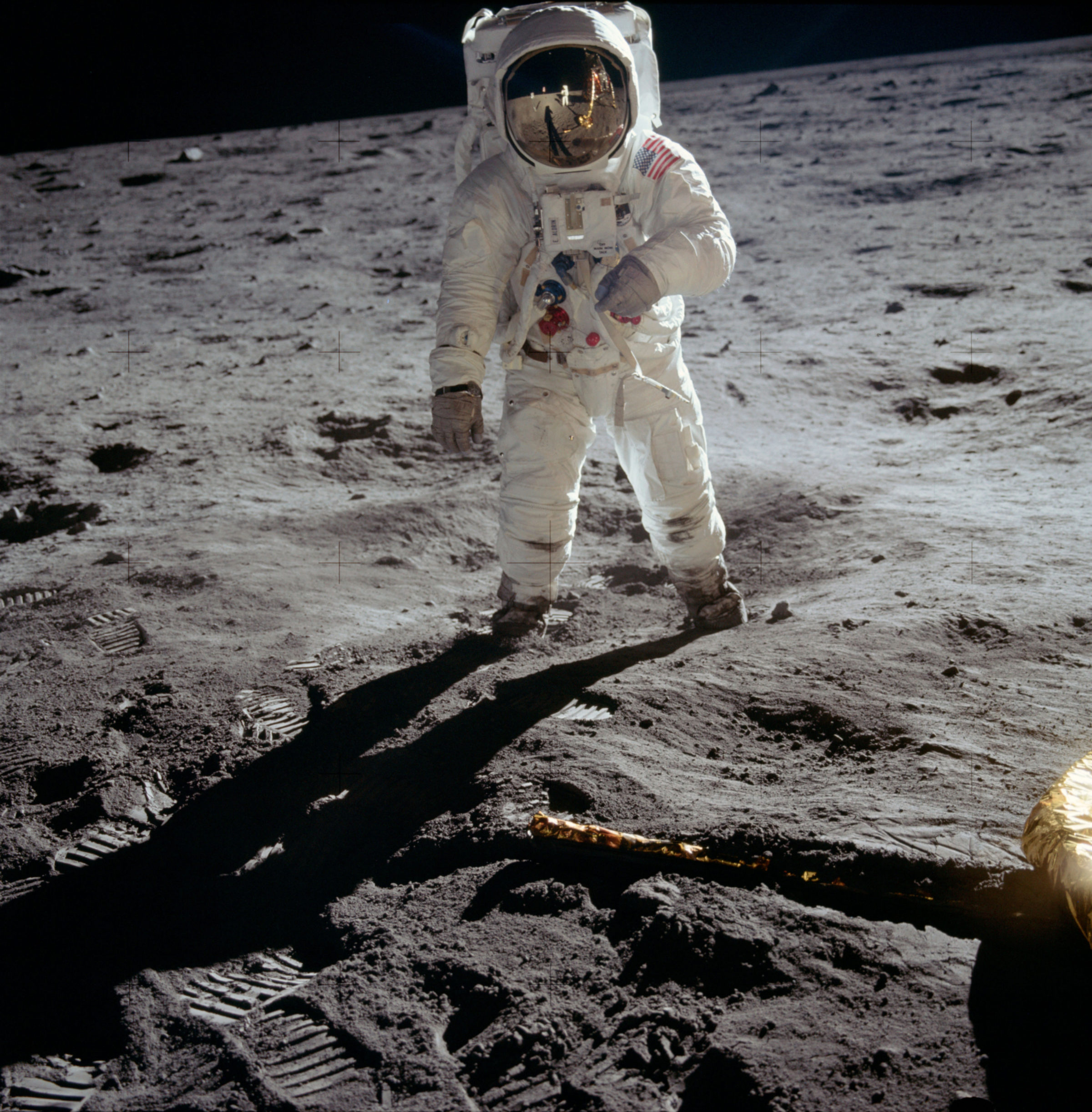
Landing Site

The Apollo 11 lunar module landing coordinates are 0.67416 degrees N, 23.47314 E. See here and here for Lunar Reconnaissance Orbiter image analysis.
Armstrong and Aldrin shot roughly 125 frames during their EVA, all on magazine 40/S, using a Hasselblad 500 EL Data Camera. Maps and descriptions of all photos are available.
Science and engineering experiments

Passive Seismic Experiment (PSE): A seismometer that failed after 21 days, but provided useful initial data on lunar seismology for future Apollo missions.
The Lunar Dust Detector: Attached to the PSE, the dust detector measured the power output from a set of solar cells to determine how much dust was thrown on nearby science instruments by the lunar module ascent engine (and in the long term, from transient lunar dust).
Laser Ranging Retroreflector (LRR): An array of small mirrors that, to this day, can be targeted by Earth-based lasers to measure the distance to the Moon. The LRR experiment has determined that the Moon is currently receding from Earth at 3.8 centimeters per year.
Solar Wind Composition Experiment: A small sheet of foil deployed and then retrieved for return to Earth, used to estimate the number of charged particles (solar wind) striking the surface.
Soil mechanics investigation: Specific experiments to investigate soil mechanics and the properties of the lunar surface. The investigation included the use of penetrometers—rods that measure the force required to penetrate to various soil depths—as well as the digging of small trenches and the collection of rocks, soil and core tubes.

After returning to the lunar module, Armstrong and Aldrin had been awake for 21 hours. The 2 astronauts slept fitfully, with Aldrin on the floor and Armstrong perched above him on the engine cowling using an improvised hammock to hold his legs off the ground. (See here for a panorama of the inside of a lunar module). The astronauts slept in their suits for warmth, as the cabin temperature dropped to 61 degrees Fahrenheit (16 Celsius).
At 17:54 UTC on 21 July, after a total of 21 hours and 36 minutes on the surface, Armstrong and Aldrin blasted off in the lunar module's ascent stage. They rendezvoused with the command module in orbit roughly three and a half hours later, rejoined Collins in the command module, and jettisoned the lunar module. The next day, on 22 July, the crew fired their service module's engines to leave lunar orbit for their long coast back to Earth. They splashed down into the Pacific Ocean at 16:50:35 UTC on 24 July and were retrieved by the USS Hornet.
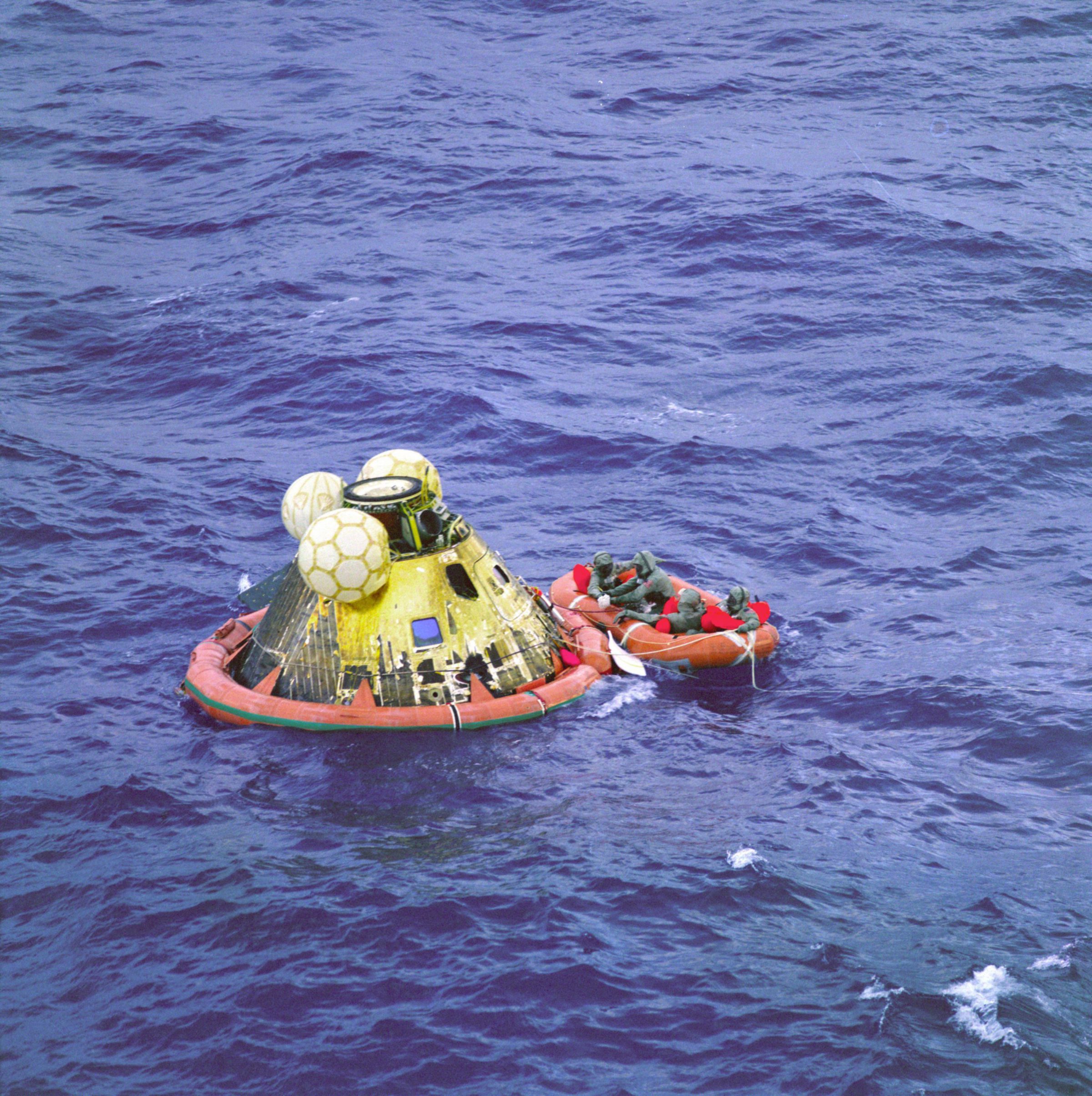
Onboard the Hornet, the crew entered a mobile quarantine facility to protect against the unlikely event that they had contracted dangerous pathogens on the lunar surface. The facility was transported back to Houston, arriving on 28 July. On 10 August, with the men showing no signs of illness 21 days after Armstrong and Aldrin's moonwalk, NASA released the crew.
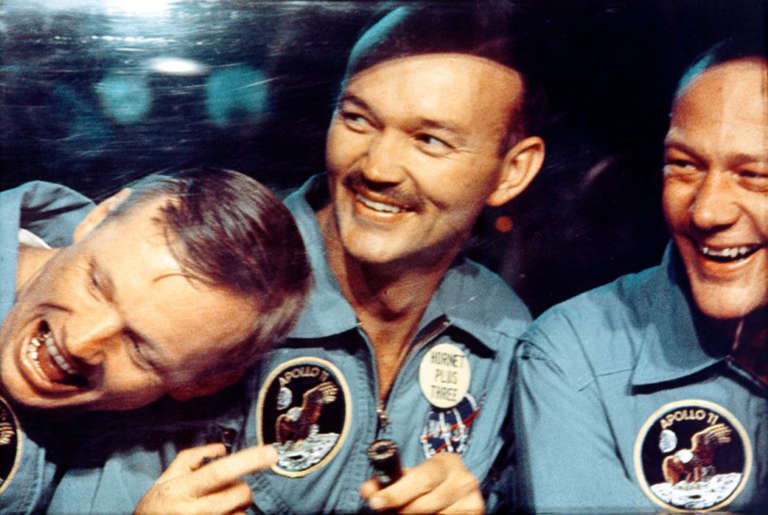
Apollo 11 Timeline
| Event | Time (UTC) | Date |
|---|---|---|
| Liftoff | 13:32:00 | 16 Jul 1969 |
| Earth orbit insertion | 13:43:49 | 16 Jul 1969 |
| Translunar injection | 16:22:13 | 16 Jul 1969 |
| CSM separation from Saturn V upper stage | 16:47:23 | 16 Jul 1969 |
| CSM docked with LM/Saturn V upper stage | 16:56:03 | 16 Jul 1969 |
| CSM/LM separation from Saturn V upper stage | 17:49:03 | 16 Jul 1969 |
| LOI burn | 17:21:50 | 19 Jul 1969 |
| Armstrong and Aldrin enter LM | 12:52 | 20 Jul 1969 |
| LM undocking | 17:44:00 | 20 Jul 1969 |
| LM descent burn | 19:08:14 | 20 Jul 1969 |
| LM begin powered descent | 20:05:05 | 20 Jul 1969 |
| LM touchdown ("The Eagle has landed...") | 20:17:39 | 20 Jul 1969 |
| EVA started (hatch open) | 02:39:33 | 21 Jul 1969 |
| Armstrong steps onto surface ("That's one small step...") | 02:56:15 | 21 Jul 1969 |
| Armstrong collects contingency sample | 03:05:58 | 21 Jul 1969 |
| Aldrin steps onto surface | 03:15:16 | 21 Jul 1969 |
| Armstrong reads plaque ("Here men from the planet Earth...") | 03:24:40 | 21 Jul 1969 |
| Aldrin deploys Solar Wind Composition Experiment | 03:35:20 | 21 Jul 1969 |
| U.S. flag deployed | 03:41:43 | 21 Jul 1969 |
| President Nixon calls astronauts | 03:48:30 | 21 Jul 1969 |
| Armstrong starts bulk sample collection | 03:52:06 | 21 Jul 1969 |
| Armstrong completes bulk sample collection | 04:07:36 | 21 Jul 1969 |
| Passive Seismic Experiment deployed | 04:27:42 | 21 Jul 1969 |
| Armstrong deploys Lunar Ranging Retroreflector | 04:35:57 | 21 Jul 1969 |
| Aldrin collects Solar Wind Composition Experiment | 04:52 | 21 Jul 1969 |
| Aldrin inside LM | 05:01:39 | 21 Jul 1969 |
| Armstrong inside LM | 05:09:32 | 21 Jul 1969 |
| EVA ended (hatch closed) | 05:11:13 | 21 Jul 1969 |
| LM ascent module liftoff | 17:54:00 | 21 Jul 1969 |
| CSM/LM docking | 21:35:00 | 21 Jul 1969 |
| LM ascent stage jettisoned | 23:41:31 | 21 Jul 1969 |
| Transearth injection burn | 04:55:42 | 22 Jul 1969 |
| CM/SM separation | 16:21:12 | 24 Jul 1969 |
| Entry interface | 16:35:05 | 24 Jul 1969 |
| Drogue parachute deployed | 16:44:06 | 24 Jul 1969 |
| Main parachute deployed | 16:47:05 | 24 Jul 1969 |
| Splashdown | 16:50:35 | 24 Jul 1969 |
| Crew onboard recovery ship | 17:53 | 24 Jul 1969 |
| Crew inside mobile quarantine facility | 17:58 | 24 Jul 1969 |
| Crew/quarantine facility arrives in Houston | 10:00 | 28 Jul 1969 |
| Crew released from quarantine | 10 Aug 1969 |
"It has a stark beauty all its own."
"Magnificent desolation."
—Neil Armstrong and Buzz Aldrin, respectively,
on the surface of the Moon
Apollo 11 Cost
NASA estimated the following direct costs for Apollo 11. Full costs of the Apollo program can be found on the "How Much Did the Apollo Program Cost?" page.
| original $ | inflation-adjusted $ | |
|---|---|---|
| Command & Service Module | $55 million | $463 million |
| Lunar Module | $40 million | $337 million |
| Saturn V Launch Vehicle | $185 million | $1.6 billion |
| Early Apollo Scientific Experiment Package (EASEP) | $5 million | $42 million |
| Operations | $70 million | $589 million |
| Total | $355 million | $3 billion |
Inflation adjusted to 2019 via NASA's New Start Index (NNSI). Source: "History of Manned Space Flight." February 1975. NASA Kennedy Space Center. Located in NASA HQ Historical Reference Collection, Washington, D.C. Record Number 18194. Box 1.
Resources
Project Apollo
Starting with Apollo 7 in 1968 and culminating with Apollo 17 in 1972, NASA launched 33 astronauts on 11 Apollo missions. Twelve humans walked on the Moon.


 Explore Worlds
Explore Worlds Find Life
Find Life Defend Earth
Defend Earth


